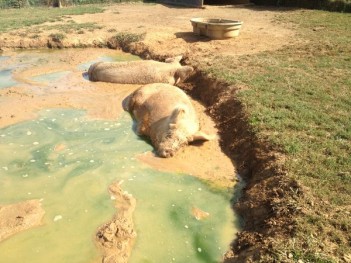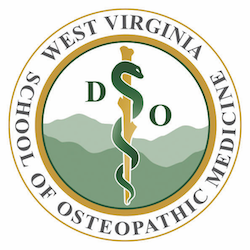
Pigs keep cool by laying in water-filled holes.
By Cheryl L. Serra
The Journal of Martinsburg
SHEPHERDSTOWN, W.Va. – Spoiled. Content. Happy as pigs in…uh…er…umm…mud.
These aren’t words that normally come to mind when describing the lives of Mr. Magoo, Duchess or Mama Leona. Abused. Neglected. Left to die. Now those words work.
Or they did, before the nearly 300 residents – pigs, dogs, cats, goats, turkeys, donkeys and all other ilk of abused, abandoned, neglected, or unwanted animals – were rescued and taken to PIGS Inc., a nonprofit animal sanctuary in Shepherdstown.
Melissa Susko, PIGS Inc.’s executive director since 2002, knows the history of each of her charges, past and present.
Take the case of Mr. Magoo, an American Bully (not to be confused with an American Bulldog) that came to PIGS via a local animal control facility. His ears are victims of home-cropping-gone-horribly-wrong; they are barely visible nubs. When Susko first saw Mr. Magoo, he was fresh from a fight or attack and his head, neck and tail were covered in oozing, open wounds. After some PIGS TLC, however, a healthy Mr. Magoo drooled as he scored an under-the-muzzle petting.
Duchess, a bloodhound, was involved in a hoarding case – too many animals and too little care. Animals in hoarding situations usually live in squalor and have unmet health needs. In Duchess’s case, she was one of more than 20 animals seized. She had given birth to many puppies and her health woes included a crushed pelvis that had healed improperly, causing her to limp.
Mama Leona, a pot-bellied pig, was removed from an abandoned mobile home and placed in the care of a small humane society in western Pennsylvania. Unfortunately, the humane society was tight for space, so Mama Leona shared a kennel with barking dogs. A few days later, Mama Leona lived up to her name and gave birth to six piglets. PIGS Inc. was asked to help, and transport was arranged.
Upon arrival at the sanctuary, Mama Leona and her piglets were weak and malnourished; Mama also had internal and external parasites. The family is doing well now, the entire waddling gang crowding toward visitors, each vying for the revered alpha position.
Living the Dream
Susko grew up in an agricultural setting in Lancaster, Pennsylvania, where she served as a veterinary technician and participated in animal rescue. She says she is now “living the dream” by overseeing the sanctuary. Some days, she says with a smirk, the dream feels more like a nightmare. For instance, a summer storm once knocked out the sanctuary’s electricity and she and the staff had to keep the animals cool and freshly watered as the temperatures inched toward 100 degrees over several days.
Jesse Ebersole works full-time at the local animal control office and, for nearly five years, has worked part-time at PIGS, where she had volunteered in the past. She says she gets the large animal experience here that she doesn’t get in her day job.
“It is the best sanctuary I’ve ever been to, and I’ve been at a bunch,” she says, adding the facility is clean and the animals are well-cared for and tended. She speaks highly of Susko’s compassion, as well.
“A lot of the animals that we [animal control] think are too far gone, Melissa takes in,” she says.
Pigs: Not Your Typical Lap Pets
PIGS Inc., was founded in 1992 in response to the large number of pot-bellied pigs – the trendy pets of the era – being abandoned. In many instances, people didn’t research the animals and didn’t realize they’d grow so big – a mature pig can reach hundreds of pounds – or how much they really like to root. They certainly don’t make good lap pets. In some instances, the owners also learn after the fact that zoning does not allow for pigs as pets in their neighborhood.
Disingenuous marketers have contributed to the problem of unwanted pigs, Susko says. Because pigs can breed at eight weeks old and the gestation period is “three, three, three” – or three months, three weeks, and three days – baby pigs essentially have babies. People who sell pigs sometimes show the young mother as an example of how large the pig can grow. Face it, piglets are cute. But they grow into big, often unwanted pigs.
“We love them, but they’re pigs. We don’t adopt them out to indoor homes,” Susko says. If someone has successfully owned a pig in the past, Susko may adopt one of the pigs she cares for to them.
PIGS is located on nearly 60 acres of pure, natural serenity. On site are isolation pens, stables for horses and donkeys, a cattery (cats are everywhere), dog runs, storage facilities and large expanses of land for the pigs to play in.
Since so many of the animals that come to PIGS have complicated medical and/or emotional needs, a history of neglect and/or abuse or diseases and ailments related to factory farming or genetic engineering, many are unadoptable. These animals can stay at PIGS – with plenty of love and attention – for the rest of their lives. Susko and her staff and volunteers place the adoptable animals in “furever” homes they vet to ensure their appropriateness for the animals.
Lifelong Lessons on Animal Kindness Taught on the Farm
But taking care of the animals is only part of Melissa’s job. Another large part of PIGS’ work is aimed at reducing the need of places like PIGS by educating children about humane treatment of farm animals.
“Why are you moving like that?” a 4-year-old visitor asks innocently as he crouches before Bounce, an orange cat with cerebellar abiotrophy, a degenerative disorder of the central nervous system that causes the cat to sway when standing, or to stagger and fall over when trying to walk. There are two other cats with the disorder at PIGS, Tipsy and Oops, as well as Dusty, a dog PIGS took in from a failing sanctuary in Delaware. The 4-year-old is visiting with a church group of children from Maryland.
As they tour the pig field, Susko asks the visitors why they think pigs like to lie in mud.
“To cool off,” responds one proud visitor.
Yes, Susko explains, to cool off, but why, she prods further? She explains that pigs cannot sweat, so they cool themselves by plunking into their mud pools. The entire tour is filled with fun facts about the animals and age-appropriate stories about how the animals wound up at the sanctuary. Visitors have also made treats, which they are taught to feed to the horses and pigs.
Carol Galvin used to work at the Humane Society in Maryland and often brought animals they received there to the sanctuary. She has worked for PIGS part-time for seven years.
“Kids are extremely honest about what happens with animals in their household. It is surprising what they say.”
In the summer of 2012, PIGS’ staff spoke about humane treatment of farm animals at a Cool to Care summer camp held by the National Humane Education Society.
Typically staff likes to bring a piglet or two so the children can see how gentle they are. But they didn’t have any piglets available to travel. Problem solved: they brought Levi wearing a pig shirt. When they introduced Levi, the children shouted, “That’s not a pig.” It sure wasn’t. Levi is a pit bull. Susko taught the children how Levi and the pigs vary (Levi doesn’t have a snout, hooves or a curly tail and doesn’t oink) and how they are similar (they are living, gentle, loving, emotional beings). It also gave Susko a chance to dispel breed-specific myths the children may have heard.
PIGS’ work occurs on the farm and in more traditional nonprofit arenas. For instance, Susko also funds their work through events such as “An Evening of Wine, Swine and Chocolate.” She establishes relationships with other animal-caring organizations like the Humane Society of United States and the Association for the Prevention of Cruelty to Animals.
Staff consists of a farm manager and up to a half dozen paid, part-time employees. She relies on a cadre of loyal volunteers. Students from nearby Shepherd University recently painted fences and helped build grant-funded isolation pens.
Most of the sanctuary’s funding comes from private donations, many of those from loyal donors. They receive less than 10 percent from grants.
“We have all the expense of a normal farm, but we don’t produce anything,” Melissa says.
An Otherworldly Feeling
Jimma Crockett had been volunteering at PIGS for three months when Susko asked her to be a board member. PIGS has a special place in her life.
“I come down this road and I swear, everything is lifted off my shoulders,” she says.
“Honest to goodness, what an honor to be associated with PIGS. I am humbled by this place. Every animal that comes through here has a forever home, whether they’re here for one day or 20 years.”
Ebersole also notes the ethereal feeling of PIGS.
“It’s so peaceful,” she said. “That’s the best word I could use for it. Even when I’m in the pig field working, I’ll see something like a bird sitting on a pig’s back. It is a nice change from my regular work days. … Even the wildlife here is peaceful.”
To read additional articles from this newspaper and region, subscribe here.






